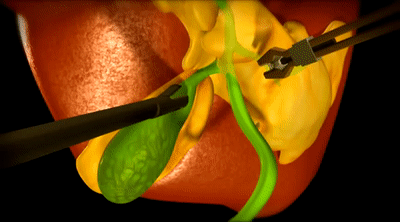Gallbladder removal or a cholescystectomy is a common surgery carried out by surgeons all over the world. The gallbladder is an organ located in our upper-right abdomen, just beneath the liver. It is the place where bile is stored. Bile is a yellow/green liquid produced by the liver when it breaks down substances in the body (including our old red blood cells).

The job of bile in the body is to emulsify fats – it does this by breaking up the fats and oils we consume into smaller droplets so that our body can digest it more easily. It also helps to neutralise the acidic chyme (food + stomach acid mixture) that leaves the stomach and enters the small intestine.
The reasons for a cholescystectomy include;
- gallstones
- gallbladder disease/infection / cholecystitis
- non-functional gallbladder/gallbladder sludge
- polyps
So what is the surgery like?
Well, these days, most cases are done laparoscopically. This means that it is done using several small incisions in the abdomen (for example in the navel, right side of the abdomen and possibly an incision in the centre of the upper-abdomen. Most patients have three or four incisions, but there are cases of people having less or more. The surgery is carried out under general anaesthetic. This means that you’ll be asleep and unaware of anything going on. Most patients are intubated (with a breathing tube) for this procedure, but are not usually catheterised. The surgery usually lasts between one and two hours. Depending on your hospital, some people may go home the same day and in others, they may be asked to stay in hospital overnight.
If you have an open surgery, the surgeon will make a large incision in the upper-right abdomen and take the gallbladder out from here. This is avoided where possible since it increases the length of time needed for recovery and hospitalisation.
During a laparascopic surgery, the surgeon will inflate the abdomen with gas. This helps provide more space in side to move around and perform the procedure. Then a camera will be inserted into one of the incisions so that the surgeon can see what he is doing. After this, various tools will be inserted into incisions to cut the gallbladder free. Medical titanium surgical clips will be placed to cut off tubes that connected the liver to the gallbladder. These metal clips will remain inside your body for the rest of your life.

Of course like any surgery, it does carry risks and there are complications that can arise. However, for this surgery, complications are rare and most patients deal with it very well.
What is the recovery period like?
Well, for me, it wasn’t too difficult. But everyone heals at different speeds and has a different experience without their gallbladder. Some people are back at work within a few days, and others may take a couple of months to get back to normal.
My advice is not to rush yourself. Recovery is an important process for our body and to recover well you need to rest and relax while trying to stay healthy. Your surgeon will give you some guidelines for aftercare and recovery, so it’s important to stick to those as much as your possibly can.

General guidelines include:
- No lifting/carrying for 6 weeks – During the surgery the abdominal muscles are often cut. Heavy lifting, carrying or even straining on the toilet can cause these muscles to separate and increase your risk of a hernia.
- No baths – whether your surgeon has used stitches or medical glue, it isn’t advisable to take a bath too early on. The water can soften the healing tissue or the glue and can increase the risk of infection. Taking a shower might be okay, but you should ask your surgeon if they recommend covering the incisions with waterproof dressings beforehand.
- Check the incision sites regularly for redness, feeling warm to the touch and weeping. Clear fluid weeping from incisions may be normal, but if the fluid is yellow and opaque and/or you have any of the above symptoms, it may be worth mentioning to your surgeon.
- Stick to a post-op gallbladder diet if given one.
- Take regular, gentle exercise but DON’T overdo it!
To read about my gallbladder story click here! Want to share your story? Get in touch with me so that we can tell your story, too!
